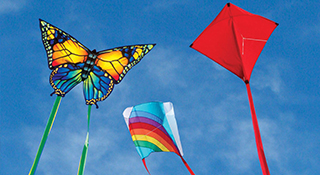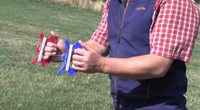Repair Instructions
The best way to avoid kite repairs is to fly within the recommended wind range for your kite and follow the assembly instructions included.
Ripstop Tape: The most common sail repairs, puncture holes or small tears in the sail, can be repaired with adhesive-backed ripstop tape. If you use white tape on the back of the kite, the original color of the sail will not be altered by the tape color when you look at the kite from the front. Cut the tape in oval or circular shapes, covering the tear and pressing the tape to the sail with the back of a spoon or other smooth object in order to burnish it effectively to the sail. If you can let it "cure" for a day before using the kite, the tape will hold better. You can sew the edges of the tape down for a permanent repair but the adhesive tends to stick to the sewing machine needle. Spraying silicone on the needle can help to keep it from sticking. Larger tears in fabric or puncture holes in high stress areas may need to have fabric patches sewn on or sail panels replaced.
Tedlar Tape: Prism recommends high-tack UV-resistant clear adhesive Tedlar tape for kite sail repairs. Although it is not as flexible and as easy to use as ripstop tape they maintain that it out performs colored ripstop tape in strength, adhesion and UV resistance. Additionally, because it has no color a repair made with Tedlar is practically invisible while flying and can be used to repair any color of sail material. Prism provides the following Tedlar repair instructions: Tedlar should always be used on both the front and the back of the sail. Corners should be rounded, and the patch should be large enough to stay approximately ½" beyond the extent of the tear. Tedlar is viciously sticky. Handling and placing it once the backing is removed requires a little practice. Once the tape is positioned and stuck down, burnish the repair thoroughly against a hard table surface by placing a piece of paper over the repaired area and rubbing hard with the back of a spoon or similar object. This embeds the adhesive in the ripstop sail material and insures optimal adhesion.
Hot Stuff Glue: This glue is formulated to fill small gaps between surfaces to be glued resulting in a better bond. It works very well for gluing ferrules, nocks and dihedrals to graphite and fiberglass spars. When gluing a ferrule to a spar, apply glue to both surfaces, and place half of the ferrule inside or over the spar, twisting it in place to evenly spread the glue over the two areas. As with all instant glues, avoid skin and eye exposure. Fingernail polish remover is a solvent.
Zona Hacksaw: This hacksaw can be used to cut wood and fiberglass spars. Choose the appropriate blade for the material that needs to be cut. To prevent the spar material from splintering while being cut, wrap the area next to the cut with masking tape and turn the spar while cutting. Although a high-speed cutting disc is the recommended tool for cutting graphite, it can also be cut using a hacksaw by scoring all the way around the spar, cutting most of the way through, then snapping off the end and sanding the rough edge. Sand the ends of wood spars and use vinyl end caps on graphite and fiberglass spars to protect the pockets and sleeves.
Replacing Wood Spars with Fiberglass or Graphite Spars: Solid fiberglass spars are four times heavier than the same diameter wood dowel. This can significantly change a kite's wind range. They are also more abrasive and can cut through spar pockets more quickly than wood. Since they are also more flexible than the same size wood dowel, this can affect how the kite flies. Fiberglass tubing is stiffer and lighter than solid fiberglass. It is also more expensive and is generally only available in shorter lengths which mean that it may need to be ferruled to replace a comparable wood spar. Fiberglass tubing and wood spars that are the same diameter weigh about the same amount. Graphite spars are lighter and stiffer than similarly sized fiberglass spars. They are generally smaller in diameter than other spars and are shorter in length than wood dowels and fiberglass rods. Although they are durable, they are the most expensive framing material and because of their small diameter may not be as easily substituted for other spars, especially wood dowels. However, we have generic Avia fittings (Center T's, spreader connectors, nocks and ferrules) to fit almost all sizes of graphite rod and tubing that we sell. This makes the transition from odd-sized, discontinued spars to an all-Avia framed kite relatively simple.


